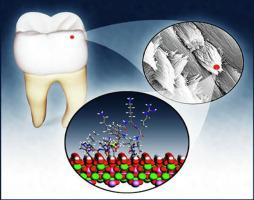Journal of Structural Biology ( IF 3.0 ) Pub Date : 2020-09-24 , DOI: 10.1016/j.jsb.2020.107630 Wendy J Shaw 1 , Barbara J Tarasevich 1 , Garry W Buchko 2 , Rajith M J Arachchige 1 , Sarah D Burton 3

|
Amelogenin, a protein critical to enamel formation, is presented as a model for understanding how the structure of biomineralization proteins orchestrate biomineral formation. Amelogenin is the predominant biomineralization protein in the early stages of enamel formation and contributes to the controlled formation of hydroxyapatite (HAP) enamel crystals. The resulting enamel mineral is one of the hardest tissues in the human body and one of the hardest biominerals in nature. Structural studies have been hindered by the lack of techniques to evaluate surface adsorbed proteins and by amelogenin’s disposition to self-assemble. Recent advancements in solution and solid state nuclear magnetic resonance (NMR) spectroscopy, atomic force microscopy (AFM), and recombinant isotope labeling strategies are now enabling detailed structural studies. These recent studies, coupled with insights from techniques such as CD and IR spectroscopy and computational methodologies, are contributing to important advancements in our structural understanding of amelogenesis. In this review we focus on recent advances in solution and solid state NMR spectroscopy and in situ AFM that reveal new insights into the secondary, tertiary, and quaternary structure of amelogenin by itself and in contact with HAP. These studies have increased our understanding of the interface between amelogenin and HAP and how amelogenin controls enamel formation.
中文翻译:

自然控制:溶液中和羟基磷灰石上釉质蛋白釉原蛋白的二级、三级和四级结构
釉原蛋白是一种对牙釉质形成至关重要的蛋白质,它被作为理解生物矿化蛋白质的结构如何协调生物矿物质形成的模型。牙釉蛋白是牙釉质形成早期的主要生物矿化蛋白,有助于控制羟基磷灰石 (HAP) 牙釉质晶体的形成。由此产生的牙釉质矿物质是人体最坚硬的组织之一,也是自然界最坚硬的生物矿物质之一。由于缺乏评估表面吸附蛋白质的技术以及釉原蛋白的自组装倾向,结构研究受到阻碍。溶液和固态核磁共振 (NMR) 光谱、原子力显微镜 (AFM) 和重组同位素标记策略的最新进展现在可以实现详细的结构研究。这些最近的研究,加上 CD 和 IR 光谱以及计算方法等技术的见解,正在为我们对釉质形成的结构理解做出重要贡献。在这篇综述中,我们重点关注溶液和固态 NMR 光谱以及原位AFM 的最新进展,这些进展揭示了对牙釉蛋白本身以及与 HAP 接触的二级、三级和四级结构的新见解。这些研究增加了我们对牙釉蛋白和 HAP 之间的界面以及牙釉蛋白如何控制牙釉质形成的理解。











































 京公网安备 11010802027423号
京公网安备 11010802027423号